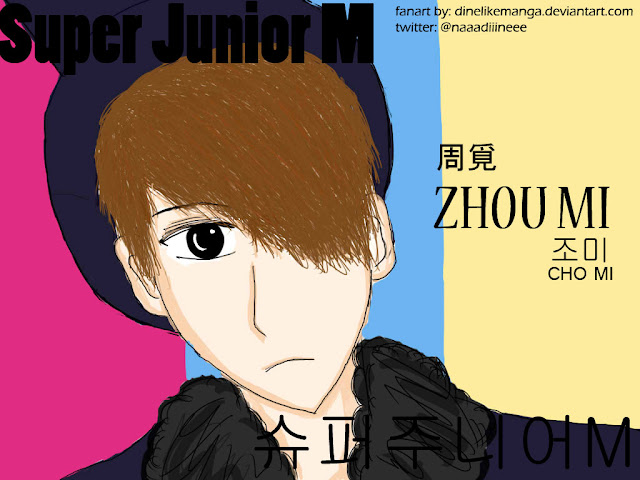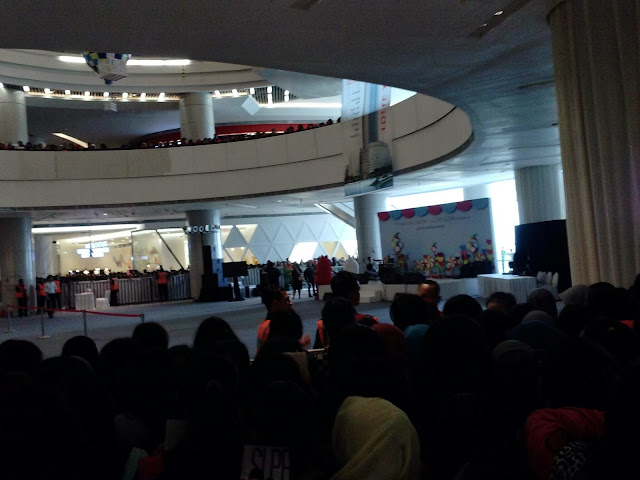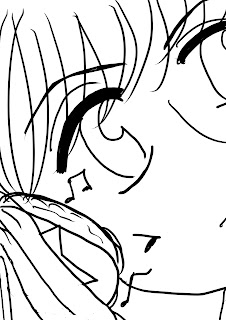Masashi Kisimoto (Pengarang Komik Naruto)
Masashi Kishimoto Dari Wikipedia, ensiklopedia bebas
Dalam hal ini nama Jepang, nama keluarga Kishimoto.
Masashi Kishimoto Lahir Masashi Kishimoto 岸 本 斉 史 November 8, 1974 (1974/11/08) (umur 35) Nagi, Okayama, Jepang Residence Prefektur Okayama, Jepang Jepang Kewarganegaraan Jepang Manga pendudukan artis Tinggi 170 cm [1] Berat 57 kg [1] Dikenal Naruto Kerabat Seishi Kishimoto (saudara kembar)
Masashi Kishimoto (岸 本 斉 史, Kishimoto Masashi?) (Lahir 8 November, 1974 [1]) adalah seorang seniman manga Jepang, terkenal karena menciptakan manga Naruto. Adik saudara kembarnya, Seishi Kishimoto, juga seorang seniman manga dan pembuat manga 666 setan dan Blazer Drive. Dua mantan asistennya, Osamu Kajisa (Tattoo Hearts) dan Yuuichi Itakura (Hand's), juga telah pergi pada kesuksesan moderat berikut pekerjaan mereka di Naruto. Karya :
Pertama Kishimoto bekerja sebagai seniman manga Karakuri, yang disampaikan kepada Shueisha pada tahun 1995. Ini menyebabkan ia banyak Weekly Shonen Jump bulanan "Langkah Hop Award," yang diberikan kepada seniman manga baru yang menjanjikan. Pada tahun 1999, Naruto adalah serial dalam Weekly Shonen Jump. Naruto masih berlangsung, dengan lebih dari 49 jilid dan hanya di atas 46 dirilis dalam bahasa Inggris, dan telah terjual lebih dari 100 juta kopi di Jepang dan lebih dari 4 juta eksemplar terjual di Amerika Serikat [5] diikuti oleh lebih dari 93 juta kopi di seluruh dunia (di luar Jepang dan Amerika Serikat) sebagai volume 36, juga sedang diadaptasi menjadi dua anime sukses. Naruto manga telah menjadi salah satu top Viz Media properti, [6] akuntansi selama hampir 10% dari seluruh penjualan manga di tahun 2006. [7] volume ketujuh pembebasan Viz menjadi manga pertama yang pernah memenangkan Quill Award ketika mengklaim penghargaan sebagai "Best Graphic Novel" pada 2006. [7] Selain bekerja di manga, Kishimoto juga merancang kostum tambahan untuk karakter permainan video Lars Alexandersson untuk Tekken 6. [8]
Dalam wawancara dan eksklusif dalam manga Naruto, dia sering menyebutkan almarhum tanaman, UKKI-kun. [9] Menurut Kishimoto, pertama kali ia memiliki pabrik kantor, karena suasana negara yang hilang, ia memberinya makan makanan pabrik yang belum dicairkan . Dia melanjutkan pembelian beberapa tanaman lain setelah itu, tapi banyak dari mereka tewas.
Pengaruh :
Ketika Kishimoto ini awalnya menciptakan seri Naruto, dia melihat ke Shonen lain manga untuk pengaruh ketika mencoba untuk membuat karakter yang unik mungkin. [10] Kishimoto mengutip Akira Toriyama's Dragon Ball seri sebagai salah satu dari pengaruh ini, mencatat bahwa Son Goku, yang pemeran utama Dragon Ball, adalah faktor kunci ketika membuat Naruto Uzumaki karena ia energik dan nakal kepribadian. [11] Untuk melengkapi karakter Naruto, Kishimoto bekerja pada penciptaan saingan itu adalah "keren jenius", karena ia percaya ini adalah " saingan yang tipikal karakter ". Setelah meninjau manga untuk ide-ide yang berbeda, ia akhirnya dikembangkan Sasuke Uchiha. Ketika menciptakan tokoh utama, Kishimoto mengakui, "Saya tidak punya gambar yang pasti tentang apa yang seorang pahlawan wanita harus". Dia akhirnya menciptakan Sakura Haruno, menekankan "genit energi dan semangat" sebagai ciri utamanya. Tiga karakter ini akan menjadi cetakan untuk tiga lainnya Naruto utama tim. [12] Untuk Kishimoto, Sasuke tetap karakter yang paling sulit baginya untuk menggambar. Sementara menggambar, kesalahan dan kecelakaan sering mengakibatkan penampilan muda Sasuke tersesat, akibat Kishimoto yang belum berpengalaman dalam menggambar karakter dewasa di luar tahun. [13] Meskipun waktu dan menghabiskan energi Kishimoto menggambar Sasuke, Sasuke telah menjadi karakter favoritnya.
Ketika menggambar karakter, Kishimoto mengikuti lima langkah proses yang ia konsisten berikut: konsep dan sketsa kasar, penyusunan, tinta, shading, dan mewarnai. Langkah-langkah ini diikuti ketika ia menggambar manga yang sebenarnya dan membuat ilustrasi warna yang biasanya menghiasi sampul Tankōbon, sampul Weekly Shonen Jump, atau media lain, tapi kadang-kadang toolkit ia memanfaatkan perubahan. [14] Sebagai contoh, ia dimanfaatkan sebuah airbrush untuk satu ilustrasi untuk sampul Weekly Shonen Jump, tetapi memutuskan untuk tidak menggunakannya untuk gambar masa depan sebagian besar disebabkan oleh pembersihan diperlukan.
Ketika Kishimoto adalah menciptakan setting manga Naruto, dia awalnya berkonsentrasi pada desain untuk desa Konohagakure, pengaturan utama dari seri. Kishimoto menyatakan bahwa desain untuk Konohagakure diciptakan "cukup secara spontan tanpa banyak berpikir", tetapi mengakui bahwa pemandangan ini didasarkan pada rumahnya di Prefektur Okayama. Kishimoto diciptakan Konohagakure tanpa menentukan masa tertentu atau lokasi di dunia nyata, mencatat bahwa desa adalah "hanya sebuah tempat di [nya] kepala". Tanpa periode waktu tertentu, Kishimoto termasuk unsur-unsur modern dalam seri seperti toko-toko, namun secara khusus dikecualikan proyektil senjata dan kendaraan dari alur cerita. Untuk bahan referensi, Kishimoto melakukan penelitian sendiri ke dalam bahasa Jepang dan menyinggung budaya dalam pekerjaannya. Dalam sebuah wawancara, ia berkomentar bahwa dia "sering dilihat jepang kebun dan [pergi] untuk pertunjukan Kabuki" untuk bahan referensi.
Kishimoto menambahkan bahwa, sebagai Naruto berlangsung di sebuah "dunia fantasi Jepang," sang pencipta harus "menetapkan aturan-aturan tertentu, dengan cara yang sistematis" sehingga ia bisa dengan mudah "menyampaikan cerita". Kishimoto ingin "menarik" tradisi zodiak Cina, yang memiliki kehadiran lama di Jepang, tanda tangan zodiak berasal dari ini. Teknologi Mengenai Kishimoto mengatakan bahwa Naruto tidak akan memiliki senjata api. Dia bilang dia mungkin termasuk mobil, pesawat terbang, dan "rendah pengolahan" komputer; Kishimoto tertentu komputer akan "mungkin" menjadi delapan-bit dan bahwa mereka akan "tidak jelas" menjadi enam belas-bit. Manga
* Karakuri satu-shot (1996, pemenang Penghargaan Langkah Hop, diterbitkan dalam Seleksi Penghargaan Langkah Hop 18 ('95 ~ '96) (1996), Akamaru Langsung Winter (1997), dan Naruto: The Official Premium Fanbook (2009))
* Naruto pilot (1997, diterbitkan dalam Akamaru Langsung Summer (1997) dan Naruto: The Official Fanbook (2002))
* Karakuri (April 1998 - Mei 1998, serial dalam Weekly Shonen Jump)
* Naruto (November 1999 - berkelanjutan, serial dalam Weekly Shonen Jump)
Buku
* Naruto: Pertama Official Data Book (NARUTO-ナルト - [秘 伝 临 の 書] キャラクターオフィシャルデータ BUKU, Naruto Hiden: Rin no Sho Deta Kyarakutā Ofisharu Buku?, Lit. "Naruto [Rahasia Buku: Record of Konfrontasi] Karakter resmi Data Book ") [18]
* Naruto: The Official Fanbook (NARUTO-ナルト - [秘 伝 兵 の 書] オフォシャルファン BUKU, Naruto Hiden: Hyo no Sho Fan Ofisharu Buku?, Lit. "Naruto [Rahasia Buku: Record of Warriors] Official Fan Book ") [19]
* The Art of Naruto: Uzumaki (岸 本 斉 史 画集 Uzumaki, Masashi Kishimoto Gashū: Uzumaki?, Lit. "The Art of Masashi Kishimoto: Uzumaki") [20]
* Naruto: Second Official Data Book (NARUTO-ナルト - [秘 伝 闘 の 書] キャラクターオフィシャルデータ BUKU, Naruto Hiden: Untuk tidak Sho Buku Deta Kyarakutā Ofisharu?, Lit. "Naruto [Rahasia Buku: Record of Battle] Karakter resmi Data Book ") [21]
* Paint Langsung: Art of Naruto (PAINT JUMP Art of NARUTO-ナルト -?) [22]
* Naruto: Ketiga Official Data Book (NARUTO-ナルト - [秘 伝 者 の 書] キャラクターオフィシャルデータ BUKU, Naruto Hiden: Sha no Sho Buku Deta Kyarakutā Ofisharu?, Lit. "Naruto [Rahasia Buku: Record of Seseorang] Karakter resmi Data Book ") [23]
* The Art of Naruto: Naruto (NARUTO-ナルト - NARUTO イラスト 集, Naruto Irasuto-Shu: Naruto?, Lit. "Naruto Ilustrasi Koleksi: Naruto") [24]
* Naruto: The Official Premium Fanbook (NARUTO-ナルト - [秘 伝 皆 の 書] オフィシャルプレミアムファン BUKU, Naruto Hiden: Kai tidak Sho Fan Ofisharu Puremiamu Buku?, Lit. "Naruto [Rahasia Buku: Record of Setiap orang] Official Premium Fan Book ") [25]
English Language :
Masashi Kishimoto
From Wikipedia, the free encyclopedia
- In this Japanese name, the family name is Kishimoto.
| Masashi Kishimoto | |
|---|---|
| Born | Kishimoto Masashi 岸本 斉史 November 8, 1974 Nagi, Okayama, Japan |
| Residence | Okayama Prefecture, Japan |
| Nationality | Japanese |
| Occupation | Manga artist |
| Height | 170 cm[1] |
| Weight | 57 kg[1] |
| Known for | Naruto |
| Relatives | Seishi Kishimoto (twin-brother) |
Works
Kishimoto's first work as a manga artist was Karakuri, which he submitted to Shueisha in 1995. This earned him the Weekly Shōnen Jump's monthly "Hop Step Award," granted to promising new manga artists. In 1999, Naruto was serialized in Weekly Shōnen Jump. Naruto is still ongoing, with more than 49 volumes and just over 46 released in English, and has sold over 100 million copies in Japan and over 4 million copies were sold in the US[5] followed by over 93 million copies worldwide (outside Japan and United States) as of volume 36, also being adapted into two successful anime series. The Naruto manga series has become one of Viz Media's top properties,[6] accounting for nearly 10% of all manga sales in 2006.[7] The seventh volume of Viz's release became the first manga to ever win a Quill Award when it claimed the award for "Best Graphic Novel" in 2006.[7] Besides his work in the manga, Kishimoto also designed an extra costume for the video game character Lars Alexandersson for Tekken 6.[8]In his interviews and exclusively in the Naruto manga, he commonly mentions his deceased plant, Ukki-kun.[9] According to Kishimoto, the first time he had an office plant, due to missing the country atmosphere, he fed it undiluted plant food. He continued purchasing several other plants afterwards, but many of them perished.[9]
Influences
When Kishimoto was originally creating the Naruto series, he looked to other shōnen manga for influences while attempting to make his characters as unique as possible.[10] Kishimoto cites Akira Toriyama's Dragon Ball series as one of these influences, noting that Son Goku, the protagonist of Dragon Ball, was a key factor when creating Naruto Uzumaki due to his energetic and mischievous personality.[11] To complement the character Naruto, Kishimoto worked on creating a rival that was a "cool genius", as he believed this was "the archetypal rival character". After reviewing different manga for ideas, he ultimately developed Sasuke Uchiha. When creating the primary heroine, Kishimoto admitted, "I don't have a definite image of what a heroine should be". He eventually created Sakura Haruno, emphasizing "her energy and flirtatious spirit" as her primary characteristics. These three characters would be the mold for the other three main Naruto teams.[12] For Kishimoto, Sasuke remains the most difficult character for him to draw. While drawing, errors and mishaps commonly result in Sasuke's youthful appearance being lost, a result of Kishimoto's inexperience in drawing characters mature beyond their years.[13] Despite the time and energy Kishimoto spends drawing Sasuke, Sasuke has become his favorite character.[13]When drawing the characters, Kishimoto follows a five-step process that he consistently follows: concept and rough sketch, drafting, inking, shading, and coloring. These steps are followed when he is drawing the actual manga and making the color illustrations that commonly adorn the cover of tankōbon, the cover of Weekly Shōnen Jump, or other media, but the toolkit he utilizes occasionally changes.[14] For instance, he utilized an airbrush for one illustration for a Weekly Shōnen Jump cover, but decided not to use it for future drawings largely due to the cleanup required.[15]
When Kishimoto was creating the setting of the Naruto manga, he initially concentrated on the designs for village of Konohagakure, the primary setting of the series. Kishimoto asserts that his design for Konohagakure was created "pretty spontaneously without much thought", but admits that the scenery is based on his home in Okayama Prefecture. Kishimoto created Konohagakure without specifying a specific era or location in the real world, noting that the village is "just a place in [his] head". Without a specific time period, Kishimoto included modern elements in the series such as convenience stores, but specifically excluded projectile weapons and vehicles from the storyline. For reference materials, Kishimoto performs his own research into Japanese culture and alludes to it in his work. In an interview, he commented that he "often visits Japanese gardens and [goes] to Kabuki performances" for reference material.[16]
Kishimoto added that, as Naruto takes place in a "Japanese fantasy world," the creator has to "set certain rules, in a systematic way" so that he could easily "convey the story". Kishimoto wanted to "draw on" the Chinese zodiac tradition, which had a long-standing presence in Japan; the zodiac hand signs originate from this. Regarding technology Kishimoto said that Naruto would not have any firearms. He said he may include automobiles, aircraft, and "low-processing" computers; Kishimoto specified the computers would "maybe" be eight-bit and that they would "definitely not" be sixteen-bit.[17]
Manga
- Karakuri one-shot (1996, Hop Step Award winner, published in Hop Step Award Selection 18 ('95~'96) (1996), Akamaru Jump Winter (1997), and Naruto: The Official Premium Fanbook (2009))
- Naruto pilot (1997, published in Akamaru Jump Summer (1997) and Naruto: The Official Fanbook (2002))
- Karakuri (April 1998 – May 1998, serialized in Weekly Shōnen Jump)
- Naruto (November 1999 – ongoing, serialized in Weekly Shōnen Jump)
Books
- Naruto: First Official Data Book (NARUTO―ナルト―[秘伝·臨の書]キャラクターオフィシャルデータBOOK Naruto Hiden: Rin no Sho Kyarakutā Ofisharu Dēta Book, lit. "Naruto [Secret Book: Record of Confrontation] Character Official Data Book")[18]
- Naruto: The Official Fanbook (NARUTO―ナルト―[秘伝·兵の書]オフォシャルファンBOOK Naruto Hiden: Hyō no Sho Ofisharu Fan Book, lit. "Naruto [Secret Book: Record of Warriors] Official Fan Book")[19]
- The Art of Naruto: Uzumaki (岸本斉史画集 UZUMAKI Kishimoto Masashi Gashū: Uzumaki, lit. "The Art of Masashi Kishimoto: Uzumaki")[20]
- Naruto: Second Official Data Book (NARUTO―ナルト―[秘伝·闘の書]キャラクターオフィシャルデータBOOK Naruto Hiden: Tō no Sho Kyarakutā Ofisharu Dēta Book, lit. "Naruto [Secret Book: Record of Battle] Character Official Data Book")[21]
- Paint Jump: Art of Naruto (PAINT JUMP Art of NARUTO-ナルト-)[22]
- Naruto: Third Official Data Book (NARUTO―ナルト―[秘伝·者の書]キャラクターオフィシャルデータBOOK Naruto Hiden: Sha no Sho Kyarakutā Ofisharu Dēta Book, lit. "Naruto [Secret Book: Record of Someone] Character Official Data Book")[23]
- The Art of Naruto: Naruto (NARUTO―ナルト―イラスト集 NARUTO Naruto Irasuto-shū: Naruto, lit. "Naruto Illustration Collection: Naruto")[24]
- Naruto: The Official Premium Fanbook (NARUTO―ナルト―[秘伝·皆の書]オフィシャルプレミアムファンBOOK Naruto Hiden: Kai no Sho Ofisharu Puremiamu Fan Book, lit. "Naruto [Secret Book: Record of Everyone] Official Premium Fan Book")[25]



Comments